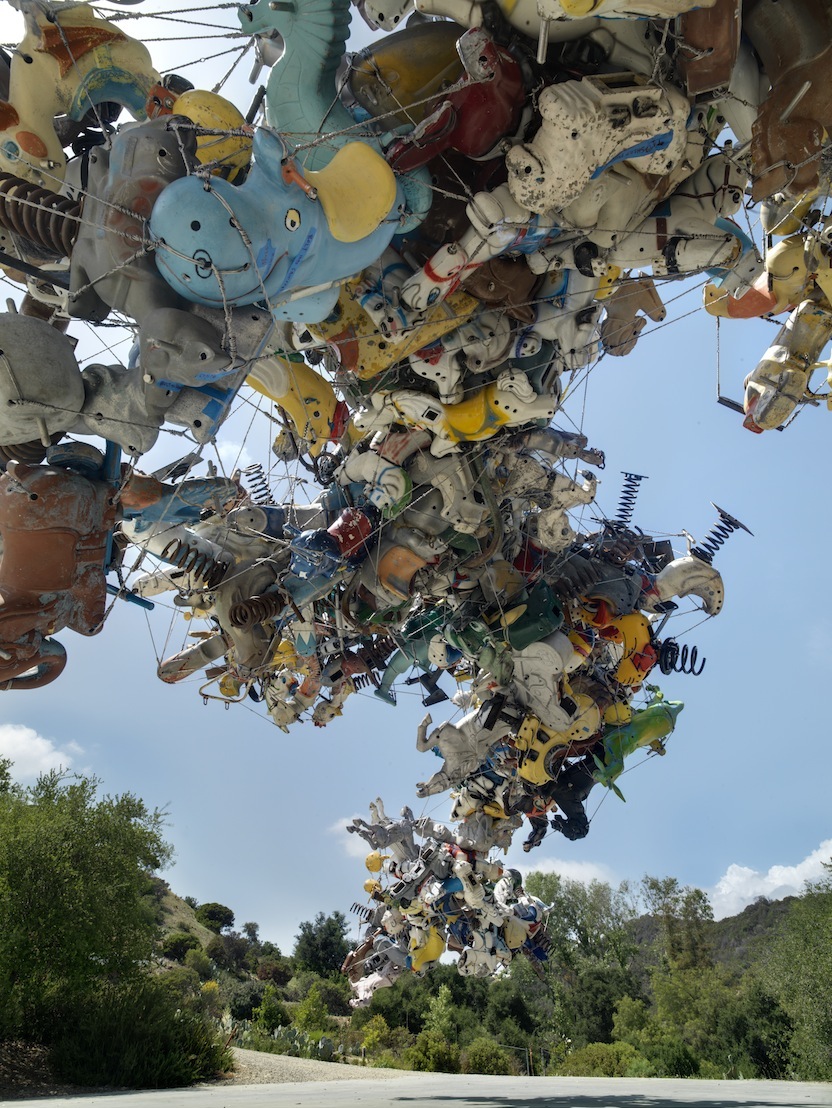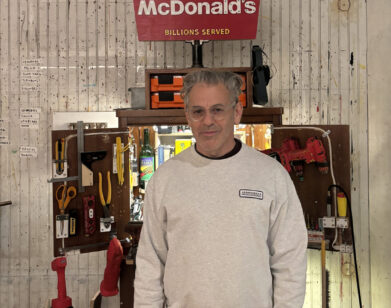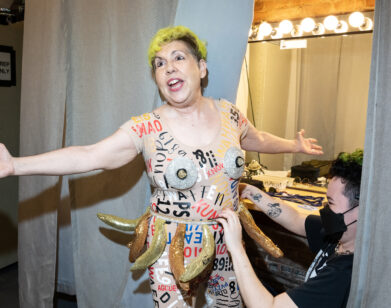What Nancy Rubins does with 20,000 Pounds of Metal
ABOVE: NANCY RUBINS PORTRAIT BY VICENTE MUÑOZ. TAKEN ON LOCATION AT THE WEST 21 STREET GAGOSIAN GALLERY IN NEW YORK.
To artist Nancy Rubins, a hunk of trash isn’t the end–it’s a new opportunity. Take her recent series at Gagosian, “Our Friend Fluid Metal.” The four sculptures consist of aluminum children’s playground toys, bound in twisting spires by tangled steel cords. When she discovered the discarded objects a few years ago, she realized they were made of the same material as World War II planes, a medium she first used in the 1990s.
That got her thinking. “Before it was in the airplanes for the war effort, it was something else. And before that it was in the earth. And before it was in the earth it was part of the solar system, flying around in globs and stars exploding and meteorites,” she says. “I’m catching it in between, as children’s toys.”
The aluminum probably doesn’t know it, but it’s the core of Rubins’s latest works, the most recent results of her long relationship with others’ junk–or, in art-world jargon, “found objects.” She’s been working steadily since the early 1990s, though the massive volume of her sculptures warrants a slower output than most. In the past, she’s used hundreds of metal boats, blooming in Lincoln Center for Big Pleasure Point (2006). She repeated the feat with some variations in Las Vegas and Chicago—the series is known as Monochrome. 10,000 pounds of mattresses and 1,000 pounds of cake were the materials for her aptly titled 1993 Whitney Biennial piece, Mattresses and Cake. A veritable edifice of discarded electric appliances made up Worlds Apart (1982) in Washington, D.C., one of her earliest public commissions.
Before the big stuff, a young, recently graduated Rubins was digging through thrift store bins in a late 1970s San Francisco for scraps of inspiration. “I could get great stuff for almost free, and that was like caviar for me,” she remembers. Early experiments involved everything from hairdryers to televisions to waffle irons. Though it was generally loathed by the city, Worlds Apart put her on the map, attracting the attention of MoCA Los Angeles chief curator Paul Schimmel, who in 1992 placed her in a popular show about contemporary Los Angeles artists. The next year, she easily landed a commission for the Whitney Biennial.
Fast forward about two decades, and Rubins can be found outside of her suburban Topanga Canyon, California studio working closely with a trusted engineer to hoist 20,000 pounds of aluminum animals into elaborate configurations. She chuckles when we ask if there’s spontaneity involved.
RACHEL SMALL: Tell me a little bit about the show. How did it come to be? What are the underlying ideas?
NANCY RUBINS: The name of the work in the show is a series called “Our Friend Fluid Metal.” It’s a sculpture made of a mass of multiplicity of these aluminum doo-dads that I’ve been accumulating.
For many years I was working with airplane parts. I would buy them in mass quantities. When I first started buying them, they were 10 cents a pound–[for] scrap. I made friends with this gentleman in the Mojave Desert named Mr. Huffman and he had mounds of scrap of airplane parts.
SMALL: How did he get them?
RUBINS: There’s airports there. The space shuttle lands out there. There’s an army and air force base out there. Also he would just accumulate those scrap airplane parts. When I first met him, he showed a picture of himself to me with a mobile smelting unit from the early ’50s. He has this mobile smelter that he took throughout the southwest Arizona and New Mexico, places like that, where the fleets after World War II were stored, and he melted it down.
As I started looking at these little aluminum doo-dads that I’m working with now, I realized that they were made of that aluminum. They were made at the same time, right after all that aluminum from World War II was melted down [in the 1940s and 1950s]. These things started being produced in profusion, because aluminum was super cheap. It is much cheaper to recycle aluminum than to mine it. It’s a metal that was recycled a lot.
SMALL: So, these are probably the remnants of World War II planes. Children’s toys.
RUBINS: Yeah, mostly from playgrounds. I started accumulating massive quantities of these things. When I first saw them, I was a little bit concerned about the objects. They were such specific objects. You saw a turtle, a frog, a horse, whatever these little animals were.
As a sculptor, I was concerned how to figure out how to use these things so they became something beyond those objects. So I started working with them, and I realized that if I turn them upside down, use them in massive quantities, let the springs come out, that they became abstracted forms. The color in them is beautiful. The last few years I’ve been working with monochrome elements–boats mostly [in the Monochrome series]. It was refreshing to go back to using color again. And so I realized that these new pieces became very painterly, as I built them and started looking at them. Because it was all a discovery for me. I realized I was making three-dimensional paintings. I started seeing them in early Philip Guston, when his works were abstract. Willem de Kooning is in it for me. All these kind of weird, curly shapes became curly shapes of color that I could work with. I started thinking about Roberto Matta, the surrealist. They became these huge blobs of these deeply three-dimensional paintings. So I started working with them on the ground, and then I started thinking about making these extreme cantilevers. So I’ve been developing one piece in particular, an extraordinary cantilever that I’ve been working with with my engineer–my engineer really came up with a fabulous design. You know how cables go through bridges? This is [held up] by the tension of cables going through the structure, and keeping the cantilever suspended.
SMALL: That seems pretty technically complicated. You needed an engineer?
RUBINS: Oh yeah, I work really closely with an engineer. I’ve been working with him since around 2004 or 2005.
SMALL: Obviously when artwork has to happen on such a large-scale…
RUBINS: When people walk under it, you think, “Can it possibly be outside with 18 feet of snow or wind conditions or earthquakes?” These sculptures have been designed to basically go through the apocalypse…That’s an exaggeration. They’re designed to withstand massive amounts [of strain]… like 18 feet of snow, earthquakes. They’re really built.
SMALL: How did you get them into the gallery?
RUBINS: We figured out how to build these things at my studio in California, take them apart in sections, put them on many trucks… it’s kind of like a giant jigsaw puzzle.
SMALL: Yeah. I see you’ve done these shapes…
RUBINS: You know, the sculpture is a cross between a grotto, a painting, and a sculpture.
SMALL: Did you think about how these parts have been discarded again and again?
RUBINS: What I love about them is that they’ve had so much use. The initial use of what it was before it was these objects, and then thousands of children who jumped on these things and wore them down, and they’ve been painted and re-painted again. They had their own life way before I ever got them.
SMALL: It sounds like that life was very rooted in the actual transference of material. The experience of other people in relation to this material and that sort of history… different people had different experiences around it.
RUBINS: Yeah, that’s interesting to me. It’s interesting because you get these objects and you note that they’re loaded with this history, and it’s time for me to blow a new history into it.
SMALL: What would you like that history to be now?
RUBINS: Well, it is what it is. They’re sculptures.
SMALL: In your past public works, landscapes play a part in your sculptures. Do you see these being shown anywhere else, outside of a gallery?
RUBINS: I built them outside in my studio in Topanga Canyon. It’s funny; my friend would say, “Oh my goodness! Look at the hill! It’s having a conversation with the hill!” The work is having a conversation with the hill, or there are references to oak trees. For me, I love the idea of taking it from this place where it’s built, and bringing it into a beautiful clean, white space with beautiful skylights so the history of the environment where it’s built is embedded in the sculpture. But the environment isn’t there anymore. It’s a clean space; you can see the sculpture really clearly.
SMALL: You can still go around it, move around it, 360 degrees. Seeing it against a white wall versus seeing it against a landscape is a very different experience. Having this in a gallery in New York, how does it compare to doing a public installation in Chicago or Las Vegas, or New York?
RUBINS: It’s very different. When I built the piece at Lincoln Center, it was built for that specific site. We were building it on-site, and when I would see it shaping the structures around it, I could respond to the situation. What I love about this is that I can build it in my studio. These are all new works. They’re highly experimental for me to build it in my studio, where I have peace and quiet and wasn’t under any time pressure. The piece in Lincoln Center, we built that, I believe, in six nights. Because it was at Lincoln Center and that property was so busy, we would begin at 11 at night and working into the night isn’t an easy thing to do. I love working in my studio and waking up in the morning. My crew would get there and we would work every day in a gradual way. It was a beautiful thing for me to do. I love working like that.
SMALL: Even if you did want to work at night in the desert, that’s a possibility.
RUBINS: Yeah, but I don’t. I like to work in the day. [laughs]
SMALL: Would you say you’re a morning person?
RUBINS: Yes, definitely.
SMALL: Have you ever been a night owl?
RUBINS: Never.
SMALL: Do you have a favorite sculpture or a favorite part about any of the sculptures?
RUBINS: No, I love them all. I love the way the cables and the wires are working, the density and those little delicate parts and those little passages that are little tendrils that you can walk under. It’s quite beautiful. There’s a huge mass to it, but a remarkable delicacy at the same time.
SMALL: Earlier in your career, some of your sculptures were not built to last. Why is that different with these?
RUBINS: Because they’re so good. [laughs] I think we’ve been working on these for two years now.
SMALL: You still have any of those little animals left over?
RUBINS: Yeah. I like working with them. I have other ideas.
SMALL: Can I ask what those ideas are?
RUBINS: No. They’re just ideas. If I could explain it to you, I’d be a poet. But I’m not. The words don’t come.
“OUR FRIEND FLUID METAL” WILL BE ON DISPLAY AT GAGOSIAN GALLERY ON WEST 21 STREET THROUGH SEPTEMBER 13, 2014.







